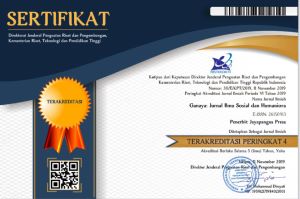Dinamika Konflik dan Jejak Perdagangan Senjata Di Tanah Papua
DOI:
https://doi.org/10.37329/ganaya.v6i4.2617Keywords:
Conflict, Arms Trade, PapuaAbstract
This research describes the conflict dynamics and traces of the arms trade in Papua. Conflict and violence in Papua have become a kind of tangled thread and is a vertical conflict that has been going on for more than 50 years. The primary reason behind this conflict stems from the aspiration for an "Independent Papua,” which was fought for by the Free Papua Organization (OPM) but is now termed by the government as an armed criminal group (KKB). This conflict is also heating up with the existence of Freeport and issues of racial discrimination against Papuan students in various regions in Indonesia. The armed conflict in Papua continues to increase, and victims come from civil society and various professions, ages, genders, religions, and ethnicities, primarily indigenous Papuans. This conflict has threatened peace efforts in Papua, Indonesia, and internationally. The intensification of the conflict is strongly linked to the rise in illegal trade of firearms and ammunition (PSAA) within the region of Papua. The primary purpose of this article is to provide an explanation and analysis of the conflict dynamics in Papua, with a particular focus on investigating the presence and impact of the arms trade within the region. The research employed a descriptive qualitative approach to empirically depict all aspects of the research problem. The study's findings and conclusions reveal the prevalence and implications of the illegal trade in firearms and ammunition that occurs in Papua involves members of the TNI and POLRI, legislators, ASN, and civil society from various professions. Weak internal monitoring and evaluation of the TNI and POLRI institutions have contributed to the increase in PSAA in the land of Papua.
References
Anderson, B. (2016). Papua Insecurities: State’s Failure in The Indonesian Periphery. Asia and The Pacific Policy Studies, 3(3).
Anugerah, B. (2019). Papua: Mengurai Konflik dan Merumuskan Solusi. Jurnal KajianLemhanas RI, 40(7).
Chauvel, Richard. (2005). Constructing Papua Nationalism: History, Etnicity,and Adaptation. East-West Center.
Elisabeth, A. C. P. (2004). Agenda dan Potensi Damai di Papua. Lembaga Ilmu Pengetahuan Indonesia (LIPI).
Ernest McCormick. (1993). Human Factors In Engineering and Design. McGraw-Hill, Inc.
Giyayi, J. (2013). Memahami papua: Dinamika Politik Identitas dan Kearifan Lokal Bangsa Papua. Cermin Papua.
Hasibuan, R. (2015). Tinjauan Yuridis Konflik Indonesia Malaysia Tentang Kepemilikan Hak Berdaulat Atas Blok Ambalat dan Ambalat Timur. Jurnal Equality, 10(02).
Hermawan Sulistyo. (2022). Intelijen dan kekuasaan Soeharto. Pustaka Obor Indonesia.
Karnavian, M. T. (2017). The Role of the National Police in Countering Insurgencies in Indonesia. Counter Terrorist: Trend and Analyses, 9(9), 8–13.
Luthfi, R. M. (2019). Relevansi Industri Pertahanan Domestik Dalam Penguatan Diplomasi Pertahanan Indonesia. Pusat Studi Pertahanan Dan Perdamaian, 4(1).
Pattipi, J. (1993). Etnografi Irian Jaya: Panduan Sosial Budaya (Buku Satu). Irian Jaya: Kelompok Peneliti Etnografi.
Pratama, A. H. (2022). Pemanfaatan Literatur Stockholm International Peace Research Institute Untuk Menyusun Indeks Ekspor Industri Pertahanan Nasional: Studi Kasus Jurnal Arms Flow to South East Asia. Jurnal Communitarian, 3(2).
RA, F. R., D. W., & A. (2019). Pendekatan Negosiasi Konflik dalam Resolusi Konflik di Sudan Selatan. Jurnal ICMES, 3(5), 57–74.
Rezki, F. A. (2022). KEMAMPUAN PT PINDAD SEBAGAI INDUSTRI PERTAHANAN NASIONAL DALAM PEMENUHAN MINIMUM ESSENTIAL FORCES (MEF)1. Nusantara; Jurnal Ilmu Pengetahuan Sosial, 9(8).
Shiddiqy, M. A. A., Bainus, A., Sumadinata, W. S., & Sudirman, A. (2019). The development of the indonesian defence industry as a consequence of security dilemma and arms race in the Southeast Asian Region. International Journal of Innovation, Creativity and Change, 10(5).
Soares, A. D. J. (2019). The Impact of Corporate Strategy on Community Dynamics: A Case Study of the Freeport Mining Company in West Papua, Indonesia. Jurnal Ilmiah Hubungan Internasional, 3(5).
Subekti. (2012). Modernisasi Alutsista TNI AD untuk Mencapai Kekuatan Pokok Minimum. Yudhagama, 32(1).
Sudira, I. N. (2017). Dialog dalam Resolusi Konflik-Interaktif. Jurnal Ilmiah Hubungan Internasional, 12(1).
Taum, Y. Y. (2017). Kekerasan Dan Konflik Di Papua: Akar Masalah Dan Strategi Mengatasinya. Jurnal Penelitian, 19(1), 1–13.
Trijono, Lambang. (2007). Otonomi Khusus dan Pembangunan Aras Lokal Papua. ANALISIS CSIS, 35(4).
Wahyudi, A. H. (2020). Analisis Implementasi Asean Defense Industry Collaboration (ADIC) dan Ketergantungan Impor Senjata Negara Anggota: Tinjauan Per Negara. Jurnal Ilmu-Ilmu Sosial, 7(2).
Widjojo, M. (2009). Papua Road Map: Negotiating the Past, Improving the Present and Securing the Future. LIPI.
Downloads
Published
How to Cite
Issue
Section
License
Copyright (c) 2023 Syahrul Akmal Latif, Muhammad Arsy Ash Shiddiqy (Author)

This work is licensed under a Creative Commons Attribution-ShareAlike 4.0 International License.
An author who publishes in the Ganaya : Jurnal Ilmu Sosial dan Humaniora agrees to the following terms:
- Author retains the copyright and grants the journal the right of first publication of the work simultaneously licensed under the Creative Commons Attribution-ShareAlike 4.0 License that allows others to share the work with an acknowledgement of the work's authorship and initial publication in this journal
- Author is able to enter into separate, additional contractual arrangements for the non-exclusive distribution of the journal's published version of the work (e.g., post it to an institutional repository or publish it in a book) with the acknowledgement of its initial publication in this journal.
- Author is permitted and encouraged to post his/her work online (e.g., in institutional repositories or on their website) prior to and during the submission process, as it can lead to productive exchanges, as well as earlier and greater citation of the published work (See The Effect of Open Access).
Read more about the Creative Commons Attribution-ShareAlike 4.0 Licence here: https://creativecommons.org/licenses/by-sa/4.0/.








